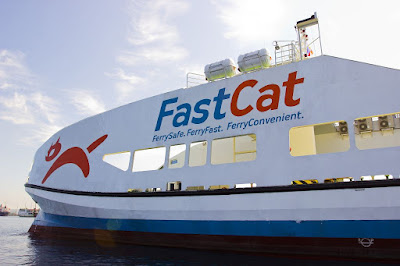2 Filipinos Who are Raising the Bar of the Local Shipping Industry
 |
| Source:https://www.evolutionpartners.com.au/fastcat-ferries-brand-promise.html |
Just last year, we had a trip to Mindoro for our 1st year anniversary. It was a very exhilarating experience for us because we had to commute instead of publicly driving southbound. From Bulacan, we had a 1 hour bus trip to Cubao then dropped off are Jam Liner terminal. From Jam, we again took a bus to Batangas Pier—a 4 hour trip including traffic. After getting to Batangas Pier was the challenging part: after battling a wave of fixers in the Pier who want to make a quick buck from us, what we were not expecting is the boat ride going to Puerto Galera. It was a big bangka, long enough that it can accommodate a about 50 passengers. It was stable though a little shaky, but the problem with this is we, me and my companion, both have sea sickness. The hot weather only triggered it more and the boat had no air conditioning. The trip was good but during those times when the waves hit our bangka, semi-rough seas got us shookt. We arrived safely but not before enduring 4 hours sea sickness onboard.
Well, that story does not differ to the story of the couple that I will feature today. Upon reading the news on Business Inquirer’s site, there is a new player in the local shipping industry scene that is coming to town, the Pastranas and the FastCat, short for Fast Catamaran. Here is how their story goes.
Early Days of the Fast Cat
The idea about the FastCat business started when Mrs. Mary Ann Pastrana thought of visiting her father in Calbayog City in Samar. It was a nightmarish ride as she felt sick after her ferry trip. One of the reasons might be the unpleasant smell, slow travel time, untrained crews, and uncomfortable seats to name some of her problems.This lead to the birth of Archipelago Philippine Ferries Corp. which now owns a total of 10 brand new two-hull Catamarans from Australia. They’re the youngest and the most-modern professionally run fleet in the Philippines today.
Why did They Do It
Since not all of the islands are reachable by land and air, trading of goods thru the sea is inevitable. Also, one of the main reasons why they are so determined to put up this business is because they believe that the number of islands and the dialects promote divisiveness among Filipinos and one thing that they can do to help is to bridge the gap among the islands by providing a safe, clean, comfortable and fast travel option.They are also into helping Filipino Seafarers by providing mentorship programs
Future Plans
Today, the company currently has 9 routes in Southern Luzon, Visayas, and Mindanao and is planning to add 30 more routes to cover the Philippines. Additional routes are also planned in Indonesia and Malaysia. For this to be feasible, Mr. Pastrana’s current fleet needs 10 more vessels.For more info, you can check out the full article here: http://business.inquirer.net/215392/fastcat-spurs-sea-change-in-travel.


Comments
Post a Comment